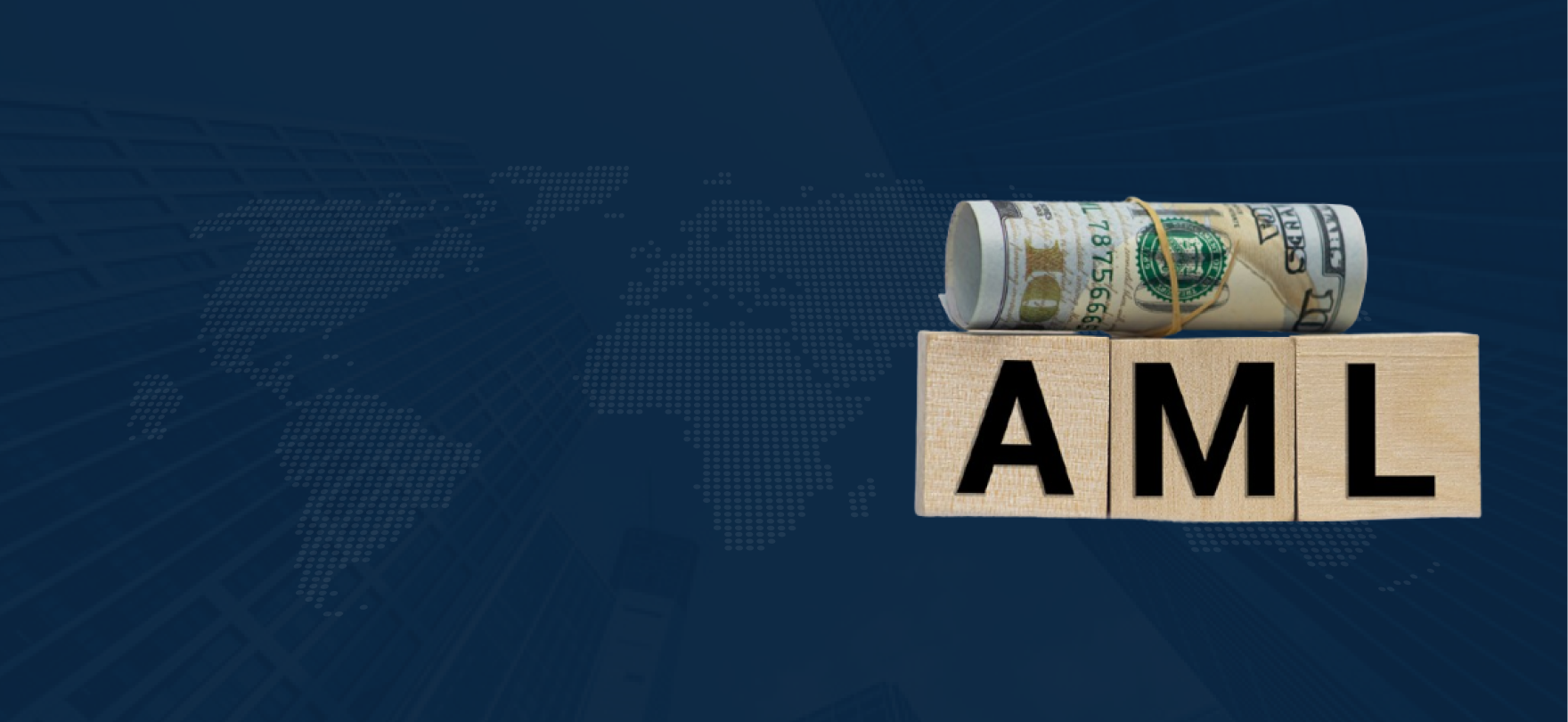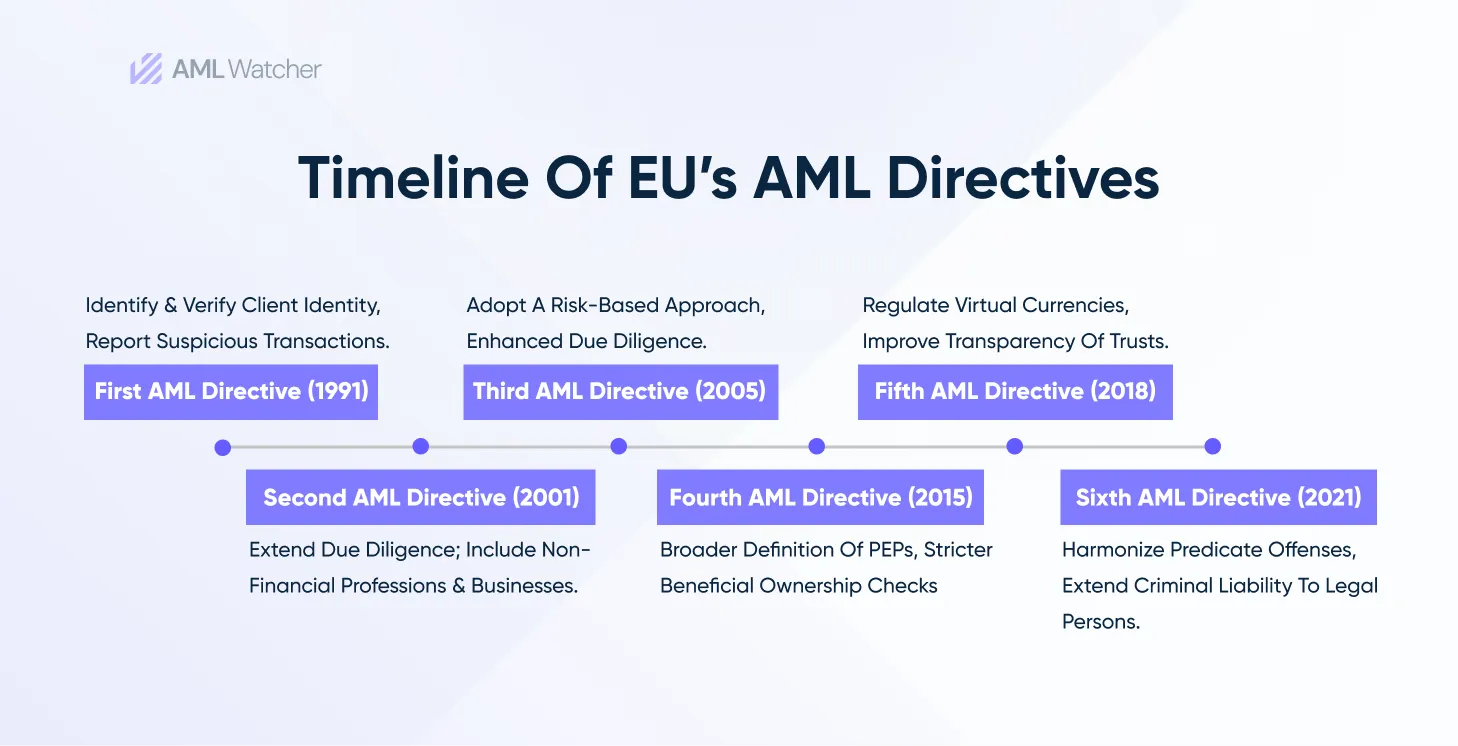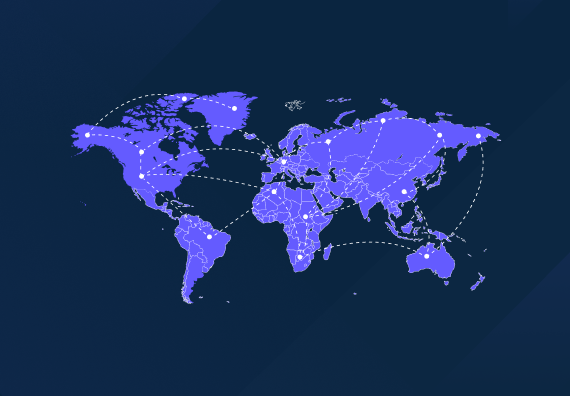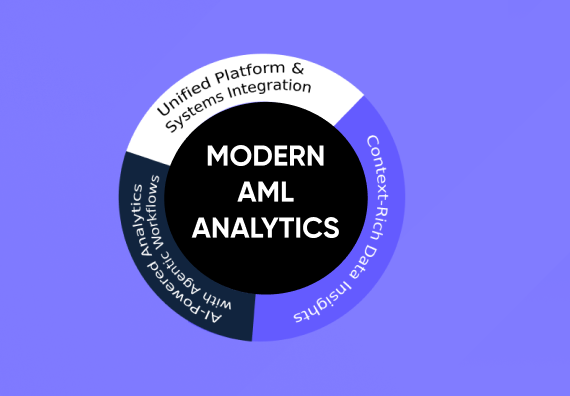
3 Decade Journey of Anti-Money Laundering AML Directives (1991 to 2024)
To cease organized criminal activities and protect the internal security of the European Union (EU), a trail of anti-money laundering AML directives was established. In a 25-year-old journey of regulatory reforms, EU anti-money laundering directives (AMLD) have been striving to address money laundering and financing of terrorism threats in the region.
Decoding the interesting facts on the most threatening criminal networks, EUROPOL published a report revealing that more than 800 organized crime networks were activated for different crimes. Out of the nominated networks, it was believed that approximately 280 of the most threatening networks had been in operation for more than 10 years. The report also highlighted that 86% of these networks successfully launder their illicit proceeds by exploiting global financial systems.
With a significant impact on global business operations, it is crucial to understand the dimensions of these directives which direct institutions particularly, financial institutions to assist in detecting and combating the flow of black money. Transforming the ways financial firms operate, anti-money laundering directives have set a precedent to ensure AML compliance in alignment with globally recognized legislation of FATF (Financial Action Task Force).
In this blog, together we will explore the journey of EU AMLD in fighting against money laundering and financing of terrorism, milestones of AMLD, compliance requirements, and major challenges in achieving AMLD goals.
A Brief Recap of Global AML Directives
The history of global legislation against money laundering and associated predicate crimes was initiated in 1989 to fight the flow of black money from organized drug cartels. In later stages, the efforts of these legislations were equally directed at combating terrorism financing, illicit money from human trafficking, corruption, and tax evasion.
With the commencement of the Vienna Convention in 1988, where 43 countries sat together to collectively regulate the actions against money laundering and other financial crimes. Infamously known as a “United Nations Conventions Against Illicit Traffic in Narcotic Drugs and Psychotropic Substances”, the Vienna Convention was arranged to particularly address drug trafficking and the associated flow of drug money.
Instead of focussing on drug trafficking, the escalated concern of money laundering was regulated with the establishment of FATF known as “a group of seven’s (G7’s)”. FATF and its 40 recommendations provide comprehensive guidelines on the adaptation of a unified approach to stem corrupt actors from abusing the financial landscape.
The efforts of AML regulations were extended to set a precedent for financial exploitation to support other criminal activities. Following the FATF’s mandate, the European Union issued its first AML directive in 1991 while the motivation behind the EU anti-money laundering directive is highlighted below.
Fast forward to the current age, the European Union has been recently being quite productive, implementing several AML directives with the latest version till now benign 6th AMLD. This version of it strengthens the existing framework by clarifying different variations in money laundering offenses and the resulting liabilities against each violation.
3 Major Motivations Behind AML Directives
A global problem carries impacts that influence the institutions on both national and international forums. Swinging between social, regulatory, and economic factors, the predicate crimes of laundering and terrorism funding motivate law enforcement agencies to enforce AML compliance in every sector mediating for the corrupt actors. Let’s move forward to explore the major motivations behind these directives.
Instability of Global Economic Landscape
In coordination with the control group of EU banks, the IMF (International Monetary Fund) has published the stats on declining equity and increasing CDS (Credit Default Swap) for financial institutions with inadequate AML measures.
The deteriorating economic and financial stability of Nigeria is one of the living examples of prevalent money laundering conditions. The vast presence of oil wealth and its positioning as the largest African economy, the country remains a prime target for money laundering among illicit actors. These acts of money laundering are mainly related to corruption and terrorist financing.
Even though the state has taken significant steps to combat money laundering, the enforcement and implementation lack the essence it takes to revert the prevalence of money laundering and promote AML regulatory reform.
The financial and economic havoc of money laundering particularly, in developing countries requires diverse and efficient anti-money laundering measures and regulatory reforms.
Corruption and Organized Crimes
The statement “not all money from corruption and tax evasion is laundered” can be negated with the fact that money laundering empowers corrupt actors to hide their illicit proceeds and enables them to enjoy luxuries without getting caught. Similarly, money laundering facilitates grounds for organized crimes and criminals to launder their gains from activities such as humans, drugs, arms trafficking, and terrorism funding. The FATF reported an increase in illicit generates from human trafficking and immigrant smuggling crossing $150 billion.
As per the report “ Human trafficking can happen in any country, it is important that countries assess how they are at risk of human trafficking and the laundering of the proceeds of this crime, share this information with stakeholders and make sure that it is understood. Countries should also build partnerships between the public sector, private sector, civil society, and non-profit communities to leverage expertise, capabilities, and partnerships. The private sector, and financial institutions in particular, are on the frontline.”
Undermined Global Security
The incident of the Twin Towers was a wake-up call for regulatory and law enforcement bodies to stem terrorist activities and their funding primarily through money laundering. Undermining global security, inadequate anti-money laundering measures provide terror activists with ample ground to collect funds from across the globe and achieve their goals. Terrorist funding of more than $35000 was unwound by the DOJ (Department of Justice) in 2022 which was collected through virtual assets.
Other than eroding the global economic infrastructure, money laundering, and associated predicate crimes have significantly affected the social and sustainable development fiber of nations. As old as the history of money laundering is, the journey of AML directives reflects the need for transformed legislation to address the issue. Let’s dig into the details of these directives and everything you need to know about it.
Year-by-Year Journey of Anti-Money Laundering Directives
The evolved EU anti-money laundering efforts are reflected through the evolution of its AML directives and related amendments to address diverse frames of money laundering and other predicate crimes.
The First AML Directive (AMLD1 – 1991)
Influenced by the FATF recommendations, CoE Strasbourg Convention.25, and the Vienna Convention, the European Community introduced its first legislation to protect financial institutions from exploitation by money launderers.
This AML directive was highly driven by the international efforts to create a coordinated response to money laundering, with influence from the Financial Action Task Force (FATF) recommendations, which emphasize the importance of a global approach to tackling these crimes, thus serving as a foundational step towards managing money laundering.
Compliance Requirements
Particularly targeting black money generated from drug trafficking, AMLD1 focussed on imposing due diligence on customers and vigilantly reporting any suspicious transactions or customer behaviors to identify and stem money laundering in banks.
Use Cases
Financial Institutions such as banks were liable to conduct customer identification before allowing them into financial systems.
Limitations
It focussed on implementing AML compliance to curb drug trafficking money and its infiltration into legitimate financial sectors.
Amendments
AMLD1 provided the basis for the EU anti-money laundering framework and gathered member jurisdictions to put unified efforts against money laundering in Europe.
The Second AML Directive (AMLD2 – 2001)
The limitations in the first AML directive were addressed by amending its compliance requirements.
Compliance Requirements
AMLD2 included institutions other than financial such as lawyers, accountants, and real estate agents, to conduct due diligence before developing a business relationship with a client.
Use Cases
EU directives extended AML laws for non-financial institutions to curb the spread of monetary exploitations from vulnerable institutions. It included lawyers, accountants, and real estate agents.
Limitations
The application of a risk-based approach, timing of conducting customer due diligence (CDD), and covering more complex but common routes of money laundering were the limitations to be addressed.
The Third AML Directive (AMLD3 – 2005)
With an introduction of simplified to enhanced due diligence, AMLD3 included financial sanctions and a robust risk-based approach depending on the risk appetite of an institution.
This particular directive was highly influenced by the aftermath of the September 11, 2001, terrorist attacks in the United States, which globally heightened the urgency to implement stringent controls to detect and prevent financial systems from being exploited by terrorists and criminal organizations.
Another driving force behind this revised version of directive was to counter the growing smart nature of methods in use by criminals to facilitate money laundering and finance terrorism.
Compliance Requirements
Addressing the gaps of the first and second directives, AMLD3 introduced a more elaborate and standardized form of guidelines for applying a risk-based approach to money laundering (ML) sensitive levels.
Use Cases
Subject to the level of risks, institutions with substandard AML measures and risk-sensitive businesses were obliged to AMLD3. It included currency exchange and money transmitters, lawyers, tax advisors, insurance intermediaries, and casinos.
Limitations
The guidelines varied for member countries and thus effective implementation of legislation was under question.
Amendments
Unlike the first two directives, the third AML directive laid significant efforts in enhanced and standard supervision and sanction implications. Exchange of information and enhanced cooperation could be seen between jurisdictions and financial intelligence units (FIUs).
The Fourth AML Directive (AMLD4 – 2015)
Introduced to become a national law for EU member states, AMLD4 empowering FATF recommendations ruled Europe for quite some time.
This directive was mainly driven by the motive to protect the financial system under the light of the 2008-2009 financial crisis, raising concerns about increasing terroirism financing in Europe and need to manage the concern.
Moreover, the revised recommendation by FATF in 2012, also made this directive undeniable for a more risk based approach towards screening.
Compliance Requirements
With the addition of extended guidelines for acquiring beneficial ownership details and PEPs politically exposed persons, AMLD4 required institutions to employ standard to enhanced due diligence measures during the business relationship and maintain SARs on transactions threshold for both wireless and cash amounts.
Use Cases
Application of AMLD4 on cash payments limited to EUR 10,000, life insurance agencies, legal professionals, tax advisors, accountants, credit and financial bodies, company service providers, and real estate agents.
Limitations
The evolved requirements for beneficial ownership details made it challenging for member states to acquire and maintain information that is generally veiled under shell companies and trust company providers.
Amendments
The mandatory loopholes in beneficial ownership information were addressed in an amendment in the fourth anti-money laundering directive in 2018.
The Fifth AML Directive (AMLD5 – 2018)
The escalated exploitation of financial services for terrorist activities motivated the EU Commission to introduce AMLD5.
Compliance Requirements
To curb the abuse of virtual assets used for financing terrorism, AMLD5 requires financial service providers to conduct due diligence for cryptocurrency users. It also included strict AML screening for high-risk third-world countries. Under AMLD5, the prepaid card limit was further reduced from €250 to €150 while the anonymous transaction limit was set to €50.
Use Cases
The directive encourages cryptocurrency and virtual wallet providers to ensure transparency in their operations and employ AML laws in their businesses to combat money laundering and financing of terrorism.
Limitations
To be implemented by 2020, AMLD5 is aimed to cover the diversified nature of virtual assets scrutiny. However, the evolving technology of the complex and anonymous nature of cryptocurrency and wallets has limited the successful implementation of the directive.
Amendments
Further amendments in the directive were brought to enhance the access to beneficial ownership detail and efficacy of FIUs.
The Sixth AML Directive (AMLD6 – 2021)
Strengthening the AML efforts, the EU’s sixth AMLD was officially named Directive (2018/1673) which was introduced to enhance AML implementations across member states and address dynamic financial crimes.
Compliance Requirements
With the addition of 22 financial offenses, AMLD6 requires institutions to conduct NRA (national risk assessment), increase the protection protocols of whistle-blowers, increase transparency in beneficial ownership data, and introduce legal clauses to use personal data for anti-money laundering.
Use Cases
All financial institutions and monetary service providers are liable to implement AMLD6 into their compliance programs. The directive introduced more stringent criminal liability upon finding noncompliance to AML regulations.
Limitations
Subject to interpretation, AML’s diversified laws make it complicated for member states to achieve unified compliance goals. The criminal offenses and their legal provisions vary in every jurisdiction which can result in uneven legal proceedings.
What’s New About AMLD in 2024
As we stepped into 2024, the year was predicted to witness many regulatory and enforcement transformations. Where technology has equipped corrupt actors to sophisticatedly launder their illicit proceeds, enhancements in AML regulations have provided a useful hand to law enforcement bodies.
Hoping to see a remarkable change in increasing money laundering activities through cryptocurrency, Bruno Le Maire, the French Minister of Economy stated that MiCA (Markets in Cryptocurrency Assets) will put an end to the crypto wild west”.
The regulatory changes are designed to improve compliance efforts and combat financial crimes, however, the dynamic nature of these laws creates hurdles in achieving a unified goal of AML. The compliance requirements of evolving AML directives might have put your mind on a rollercoaster ride while struggling to choose what’s best for your business to meet these demands. Here’s a comprehensive roadmap to achieve AML compliance goals without compromising business efficiency.
How AML Watcher Can Be Your Compliance Partner?
Efficient, easy, accurate and simplified compliance are the terms that define the mission of AML Watcher. The regulatory race might not give you enough time and space to consider your business constraints, but we do. Apart from making sure your business abides by the compliance requirements, AML watchers make sure to infuse the active monitoring and risk management strategies into your workflow.
Sourcing data from all the official data sources, in house cleaning and categorization makes AML watcher a consolidated storehouse for all the relevant sources you need for efficient AML compliance and screening needs as per your jurisdiction.
Our compliance geeks are research-driven and embed technology into AML screening tools that perfectly align with the regulatory guidelines of AML directives. In addition to tech and data-driven AML screening services, AML Watcher offers compliance partnership which helps your business to stay ahead of the compliance curves and achieve customized AML goals.
By using advanced and relevant technology to conduct deep dives into background screening detecting potential risks with precision and speed. This means fewer false positives and more accurate detection of suspicious activities.
With AML Watcher, you gain access to real-time alerts that keep you informed of any compliance issues or emerging threats, allowing for swift action and resolution. That’s not all!
Try searching in real time with an open search feature that gets you instant results for your queries against PEP and Sanctions.
We are here to consult you
Switch to AML Watcher today and reduce your current AML cost by 50% - no questions asked.
- Find right product and pricing for your business
- Get your current solution provider audit & minimise your changeover risk
- Gain expert insights with quick response time to your queries





